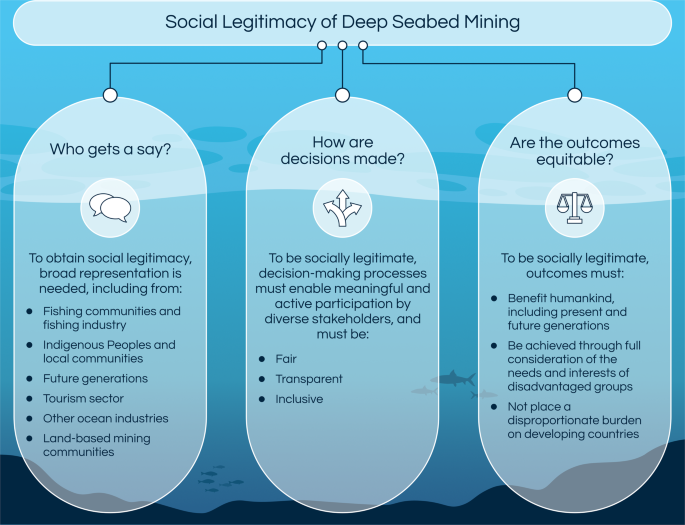Publication Details
Aline Jaeckel, Harriet Harden-Davies, Diva J. Amon, Jesse van der Grient, Quentin Hanich, Judith van Leeuwen, Holly J. Niner and Katherine Seto, Deep seabed mining lacks social legitimacy, npj Ocean Sustainability 2 (2023)
Fig. 1: The three pillars of social legitimacy as applied to deep seabed mining. Social legitimacy is created through equitable representation (who gets a say?), procedural justice (how are decisions made?), and distributional justice (are the outcomes equitable?). Figure designed by Stacey McCormack (Visual Knowledge).
Introduction
The technology to mine the ocean floor for valuable minerals such as copper, nickel, and cobalt is currently being developed. Scientists have warned repeatedly about potentially serious and irreversible environmental impacts from deep seabed mining (DSM), including but not limited to: removal and destruction of sensitive and poorly known seafloor habitats and species; metal-contaminated and fine-particle sediment plumes that can impact benthic and pelagic fauna; changes to water properties; and increases in noise and light1,2. What remains to be substantially debated are the social impacts of DSM.
After years of exploration, some companies are now pushing to begin commercial mining of the deep seabed. The International Seabed Authority (ISA), the institution responsible for regulating mining on the international seabed, is now under pressure to finalise regulations by mid-2023. This comes after Nauru triggered the so-called “two-year rule” in 2021, which calls on the ISA to finalise regulations within two years3.
Despite this rush, the social legitimacy of DSM is compromised4. Not only have major brands rejected deep-sea minerals5, but there are also growing calls for a moratorium on DSM, including from the Alliance of Countries for a Deep-Sea Mining Moratorium6, which was launched at the 2022 UN Ocean Conference. Given this opposition, there is a risk that seabed minerals will encounter consumer boycotts if the industry does not accord with societal norms and beliefs7. This in turn may jeopardise investments by DSM companies and may ultimately lead to a rejection of DSM altogether. Poignant examples include Nautilus Minerals’ failed DSM project in Papua New Guinea, which encountered financial challenges as well as public rejection8,9, and early attempts to regulate and allow mineral mining in the Antarctic, which ultimately resulted in a mining moratorium10 (1991 Protocol on Environmental Protection to the Antarctic Treaty, Article 7).
Social legitimacy of DSM relates not only to what decision is ultimately taken but also to how decisions are taken and by whom. While the ISA has legal competence to permit DSM under the UN Convention on the Law of the Sea (UNCLOS), there are concerns about whether the ISA’s current decision-making procedures do justice to its mandate to act on behalf of humankind as a whole (UNCLOS, Article 136(2)). This unique and legally binding mandate requires the ISA to consider not only profit and environmental impacts but also social and potential negative economic effects of DSM, particularly for developing states. Yet the social aspects remain understudied.
As detailed in the literature11,12 and summarised in Fig. 1, social legitimacy comprises three pillars: (a) a broad range of stakeholders, including ocean-dependent communities, need to have a say in the decision-making processes over DSM, (b) decision-making must be procedurally fair, inclusive, and transparent, and (c) the outcome must be equitable and generate social and economic benefits, as well as ensure the preservation of the marine environment. Before we assess DSM against these three dimensions below, we briefly discuss the potential impacts of DSM on people.
